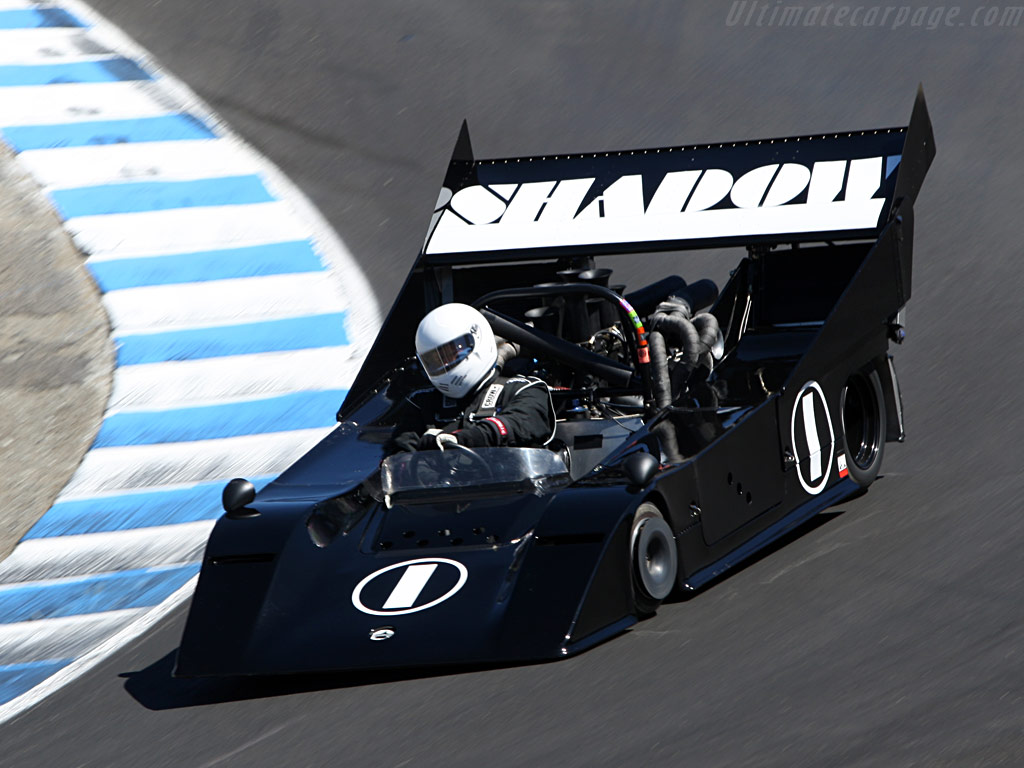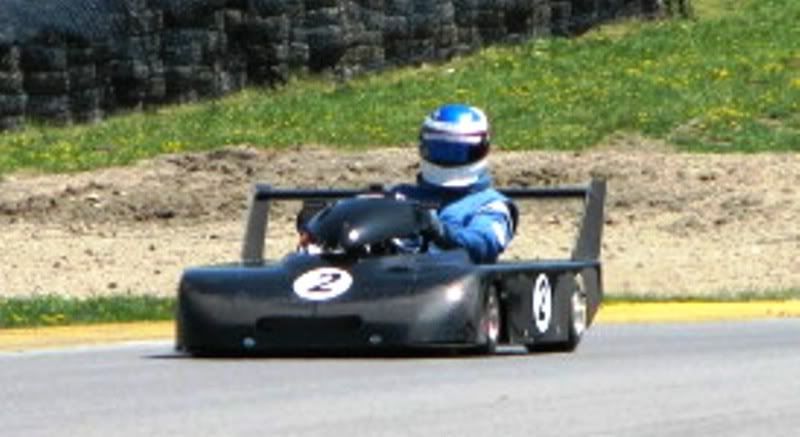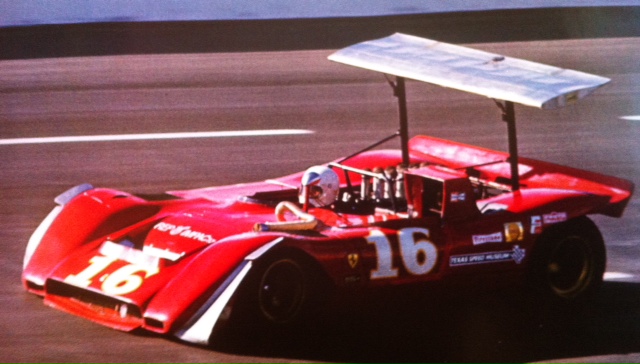|
|
Post by mikael on Nov 23, 2017 7:52:42 GMT
did Dan patent the Gurney flap? Chris, according to a nice article on Wikipedia, the Gurney flap was not patentable since, in the context of aeronautics, a similar but movable micro-flap had been patented already in 1931. (That idea was thus, apparently, unused and forgotten.) |
|
Deleted
Deleted Member
Posts: 0
|
Post by Deleted on Nov 23, 2017 7:57:59 GMT
|
|
|
|
Post by mikael on Nov 23, 2017 13:20:18 GMT
The first Shadow, designed by Trevor Harris with 10" front and 12" rear diameter wheels and bravely driven by George Follmer, while brilliantly conceived and offering tantalizing prospects for success was, like several others in the end, an engineering bridge too far. As described by its driver, "it was an absolute rocket-ship down the straight. But it wouldn't stop. And it wouldn't cool. And it bounced around like crazy because it had hardly any springs, as if the shocks had come off a Model T ... basically, it was an awful car." Carl, a most fascinating car! (Came across a nice recent photo which is included here.) Like a go-cart with a huge (eight litre!) V8 engine! Amazing!
By the way, those intake trumpets of odd lengths were often seen on Can-Am cars. It looks great - but what is the purpose of employing odd lengths? Does it flatten out the power-curve, or the torque-curve, or something like that?

|
|
|
|
Post by mikael on Nov 23, 2017 13:47:03 GMT
Not much of a difference (except for the power) ...

|
|
|
|
Post by charleselan on Nov 23, 2017 15:56:33 GMT
What a great thread René. I am getting back up to speed slowly after my trip to the UK where contact was limited at times.
People do seem to forget that Can-Am was merely a series within the Group 6 Sports Racing Car rules. These cars raced all over the globe in different series, and there were very successful and prestigious events held in the UK at many of the iconic circuits like Brands Hatch; Goodwood; Aintree; Silverstone; Snetterton and Oulton Park.
In 1964 one of the support races to the F1 Aintree 200 was for this fledgeling series and it featured live on the BBC Grandstand sports program. Jim Clark made the first race appearance of the Lotus 30 that cold sunny day, it was pretty unsorted but to this Lotus fan looked superb. Jim wrestled the beast around like no other, eventually finishing second if my memory serves me correctly. The car looked glorious as did its later brother the "40", but it was a disaster in reality thanks to Colin Chapman being somewhat smitten by the backbone chassis arrangement that worked so well in the little Elan; it just did not work with a big American V8 bolted in the back!!
Fabulous cars for a certain period until money and technology become overwhelming and ruined the concept, as it appears to do in all forms of motor sport.
JC
|
|
|
|
Post by Carl on Nov 23, 2017 18:19:43 GMT
By the way, those intake trumpets of odd lengths were often seen on Can-Am cars. It looks great - but what is the purpose of employing odd lengths? Does it flatten out the power-curve, or the torque-curve, or something like that?

Mikael, I believe your assessment is right. The different lengths and angles first appeared in 1968 and were probably intended as you suggest. As someone with incomplete technical expertise, I thought at the time that they just looked cool! The development may have come from the engine builders. One, Traco Engineering, was globally recognized as masters both at Indianapolis and with small and big block American V-8s. |
|
|
|
Post by Carl on Nov 23, 2017 18:22:12 GMT
Mikael, the story I knew, or at least I recall, is that of a German (?) engineer, Michael May, who first put a rear spoiler on a Porsche in the '50s.
This link should provide some detail:
www.mulsannescorner.com/history.htm
Lucio, That is also my understanding of the first rear spoiler. |
|
|
|
Post by René on Nov 23, 2017 23:48:07 GMT
Talking about big wings, Chris Amon in the 6 liter V-12 Ferrari Can Am at Texas Speedway 1969.   |
|
|
|
Post by René on Nov 24, 2017 17:12:08 GMT
To add some more Ferrari in the mixture (someone's gotta do it  ) here a half hearted attempt to make an impression in the Can-Am championship: the Ferrari 712 Can Am. I say half hearted because Ferrari never really put its full weight behind it. At first Ferrari seemed interested and wanted a piece of the very lucrative Can-Am pie. But that meant competing with the Chevrolet big blocks that dominated the series and Ferrari simply had no engine large enough to compete. The 1969 612 Can Am (pictured in post above) wasn't bad but lack of development let down the project. For the 1970 (edit: 1971) season Ferrari gave it another try with the 712. The 7 litre V12 engine being the biggest engine Ferrari ever build! Mario Andretti was the driver for its debut at Watkins Glen. Andretti qualified 5th (just ahead of the also new Porsche 917/10!) and finished fourth, despite a spin and losing his rear wing! But still Ferrari decided to stop the project because it would require too much resources to fully develop the car into a serious competitor to the McLaren's and Porsche's. The 712 was then sold to US Ferrari importer and friend of Enzo's Luigi Chinetti. In 1972 the 712 made two appearances for Chinetti's NART (North American Racing Team) team. Young Jean-Pierre Jarier was the driver and the aerodynamics of the car were further developed but without factory support it could not stop the success of the ever stronger factory Porsches. A tenth position at The Glen and fourth at Road America were all it had to show. The 712 made its final competitive appearance in 1974, again at Watkins Glen, now with Brian Redman behind the wheel. Brian raced from the back of the grid to second (despite never having driven the car before), before retiring with a broken suspension arm. Just as with the 512M this is another 'what if' story for Ferrari. Mario at 'The Glen' 1971 on his way to fourth place. Jarier (40) in 1972 and Redman (10) in 1974. Jarier (40) in 1972 and Redman (10) in 1974.  |
|
|
|
Post by charleselan on Nov 24, 2017 17:26:21 GMT
Sorry but that 712 was a complete tank. The best looking by far was the cut down P4 that Amon and Jonathan Williams used in Ferrari's first CanAm foray. It wasn't powerful enough but was a beauty, and none more so when Paul Hawkins bought one and ran it in South Africa in Gunston colours, maybe you have the Racer slot car  . |
|
|
|
Post by René on Nov 24, 2017 18:12:07 GMT
Sorry but that 712 was a complete tank. The best looking by far was the cut down P4 that Amon and Jonathan Williams used in Ferrari's first CanAm foray. It wasn't powerful enough but was a beauty, and none more so when Paul Hawkins bought one and ran it in South Africa in Gunston colours, maybe you have the Racer slot car  . I never said it was beautiful JC. It's a monster (without teeth) and certainly not an elegant Ferrari! I actually do not have that Racer car. Want to but missed it and now hard to get. I do have the 712 though!  A Top Slot resin body with a Fly chassis. |
|
|
|
Post by Carl on Nov 24, 2017 19:11:56 GMT
Rene, Wonderful photographs! You're exactly right about Ferrari's Can-Am attempt being half-hearted. What a massive air intake on the 612 at Texas! I wonder how much drag it produced  I'm pretty sure the Porsche 917s at Watkins Glen were non-turbocharged 917Ks. The 917-10 appeared in 1972. Brian Redman was miraculous! Underrated throughout his career, he was one of the very best. Cheers, Carl |
|
|
|
Post by René on Nov 24, 2017 23:39:53 GMT
Rene, Wonderful photographs! You're exactly right about Ferrari's Can-Am attempt being half-hearted. What a massive air intake on the 612 at Texas! I wonder how much drag it produced  I'm pretty sure the Porsche 917s at Watkins Glen were non-turbocharged 917Ks. The 917-10 appeared in 1972. Brian Redman was miraculous! Underrated throughout his career, he was one of the very best. Cheers, Carl Carl, I made an error in my post above. It was the year 1971 instead of 1970 in which the 712 made its debut at Watkins Glen. That race was however also the debut of the Porsche 917/10. See www.racingsportscars.com/photo/Watkins_Glen-1971-07-25c.html |
|
|
|
Post by Carl on Nov 25, 2017 0:44:12 GMT
Rene,
I remember that STP sponsored 917 because I normally rooted for "Seppi" Siffert. Somehow since then I came to believe the turbocharged model was the first 917-10.
By 1971 many fans had grown tired of McLaren's (well-earned) domination and hoped a brilliant driver in a new Porsche would challenge Denis Hulme and Peter Revson in their M8Fs.
The following year, with Roger Penske, Mark Donohue and Porsche's 1000 bhp turbocharged twelve, the tables completely turned. Donohue was sidelined by injury early, I believe at Mosport, and George Follmer, Penske's favorite number two, became champion. McLaren's beautiful M20 (see my avatar) was so close to the Porsche's speed, tantalizingly near, but ultimately McLaren decided they would never beat Porsche and left the series.
I was at Riverside in 1972 when the 917-10's top speed was 219 mph on the long main straight, never bettered because the next year, Mark Donohue's prediction of 250 mph in the 917-30 convinced track management to effectively halve the straight by using the short course. Everyone was disappointed that prudence was given precedence over spectacle. The acceleration of the 917-10 had seemed like an illusion and we wanted more.
Cheers, Carl
|
|
|
|
Post by Jamie on Nov 25, 2017 7:39:28 GMT
Rene, I remember that STP sponsored 917 because I normally rooted for "Seppi" Siffert. Somehow since then I came to believe the turbocharged model was the first 917-10. By 1971 many fans had grown tired of McLaren's (well-earned) domination and hoped a brilliant driver in a new Porsche would challenge Denis Hulme and Peter Revson in their M8Fs. The following year, with Roger Penske, Mark Donohue and Porsche's 1000 bhp turbocharged twelve, the tables completely turned. Donohue was sidelined by injury early, I believe at Mosport, and George Follmer, Penske's favorite number two, became champion. McLaren's beautiful M20 (see my avatar) was so close to the Porsche's speed, tantalizingly near, but ultimately McLaren decided they would never beat Porsche and left the series. I was at Riverside in 1972 when the 917-10's top speed was 219 mph on the long main straight, never bettered because the next year, Mark Donohue's prediction of 250 mph in the 917-30 convinced track management to effectively halve the straight by using the short course. Everyone was disappointed that prudence was given precedence over spectacle. The acceleration of the 917-10 had seemed like an illusion and we wanted more. Cheers, Carl How I envy you for witnessing the Can-Am in its heyday, it must have been wonderful. I remember Charles Agg racing a McLaren M8F in historics in the UK back in 90's and it was a hell of a spectacle, to see a whole grid of them in period must have been a treat indeed. How unfortunate that we'll never see the like of it again, a series with such freedom in the regulations would be manna from heaven. We used to have a series in the Uk called 'Thundersaloons' in the 80's / early 90's and I loved it for the technical differences between the cars and the hairy chested beasts it spawned.... My favourite was the 'Stars and Stripes' Opel Manta which had a massive Pontiac V8 under the bonnet. Wish we had something similar now...... Attachment DeletedCarl / All - Do you have any recommendations for a book covering the history of the Can-Am series - such a tome is a glaring omission from my little library. |
|